- 【Nacos】SpringCloud连接不上远程Nacos问题排查
- 前后端分离Springboot 整合使用activiti7教程(一)(
- CC++数据结构之链表题目答案与解析
- 从零开始实现C++ TinyWebServer(九)---- 项目知识
- MySQL中的TRUNCATE TABLE命令
- MYSQL下载及安装完整教程
- 基于springboot大学生兼职平台管理系统(完整源码+数据库)
- 微信小程序使用PHP调用后台mysql数据库-小白版
- 前端传输数组类型到后端(附代码)
- 基于Django的婚纱摄影预约系统设计与实现(Pycharm+Pyth
- 云计算时代的运维: 职业发展方向与岗位选择
- Golang 开发实战day08 - Multiple Return
- Springer Latex投稿(编写中遇到问题及解决方案)
- 【MySQL】内外连接——内连接、外连接、左外连接、右外连接、内外连接
- 如何使用群晖Synology Drive结合cpolar内网穿透实现同
- 【微服务】spring状态机模式使用详解
- 抖音六神最新算法
- Spring-Kafka 3.0 消费者消费失败处理方案
- NL2SQL基础系列(1):业界顶尖排行榜、权威测评数据集及LLM大模
- 【PyJavaC++三种语言OD2023C卷真题】20天拿下华为OD笔
- MySQL--数据的增删改
- Kafka 架构深入探索
- 创建Maven项目
- MySQL INSERT插入条件判断:如果不存在则插入
- Node.js教程(想入门就来点进来看看)
- 全网最最最最详细如何卸载centos7中安装的nginx的教程~
- 大数据技术原理及应用课实验4: NoSQL和关系数据库的操作比较
- Ubuntu系统使用Docker本地部署Android模拟器并实现公网
- 2-1.Hadoop大数据集群搭建之---本地模式
- nginx重启失败:Job for nginx.service fai
欢迎来到《小5讲堂》,大家好,我是全栈小5。
这是《Sql Server》系列文章,每篇文章将以博主理解的角度展开讲解,
特别是针对知识点的概念进行叙说,大部分文章将会对这些概念进行实际例子验证,以此达到加深对知识点的理解和掌握。
温馨提示:博主能力有限,理解水平有限,若有不对之处望指正!

目录
- 前言
- 创建表
- 模拟数据
- 分组查询
- while实现
- 游标实现
- 输出编号
- 结合临时表
- 知识点
- 游标(Cursor):
- 临时表(Temporary Table):
- 文章推荐
前言
最近在进行历史数据处理,刚开始是想着通过在后端写个逻辑处理,也非常简单。
对于数据库而言,通过sql语句处理就是最好的,方便下次再处理时有个sql语句参考,
或者也方便运维人员直接使用,后端代码逻辑处理运维人员并不一定都懂。
因此,本篇文章将模拟批量数据进行sql语句遍历处理。
创建表
创建一张学生城市表,主要字段如下
-- 创建学生城市表 create table student_table ( id int identity(1,1), name_value nvarchar(50), city_value nvarchar(50), city_value_temp nvarchar(50), create_time datetime default getdate() )模拟数据
模拟添加10条记录数据,且设置几条重复记录
-- 模拟10条记录 insert into student_table(name_value,city_value) values ('张三','广州'), ('张三','广州'), ('张三','广州'), ('李四','深圳'), ('李四','深圳'), ('王五','佛山'), ('刘六','佛山'), ('刘六','佛山'), ('张七','东莞'), ('吴八','惠州')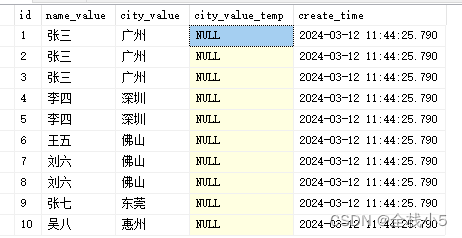
分组查询
按学生和城市分组查询,且having筛选有重复记录的数据
-- 学生和城市分组查询 - 有重复记录的数据 select name_value,city_value,count(1) repeatcount,max(id) maxid from student_table group by name_value,city_value having count(1)>1
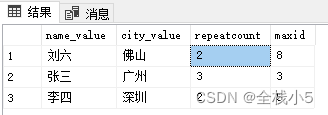
while实现
进行两次while遍历,然后将学生重复的城市值,除了编号最大那条记录外,其他重复记录则加序号值并赋值到city_value_temp字段里
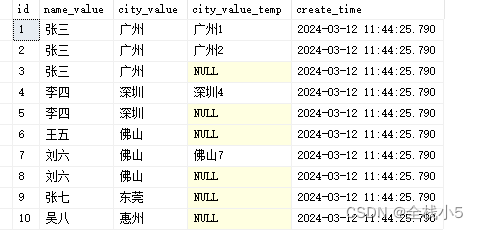
1)定义变量表 - 保存重复的学生记录
2)定量变量
3)将源表中的数据插入到表变量中
4)第一层遍历
5)第一层,每次都获取第一条记录
6)定义变量表 - 保存当前学生重复记录
7)第二层遍历
8)第二层,每次都获取第一条记录
9)将当前第二层遍历记录移除
10)更新表字段
11)将当前第一层遍历记录移除
-- =====遍历处理重复数据 - 编写处理逻辑===== -- 定义变量表 - 保存重复的学生记录 declare @temp_one_table table ( name_value nvarchar(50), city_value nvarchar(50), repeatcount int, maxid int ) -- 定量变量 declare @maxid int declare @name_value varchar(50) declare @city_value varchar(50) -- 将源表中的数据插入到表变量中 insert into @temp_one_table(name_value,city_value,repeatcount,maxid) select name_value,city_value,count(1) repeatcount,max(id) maxid from student_table group by name_value,city_value having count(1)>1 -- 第一层遍历 while exists(select city_value from @temp_one_table) begin -- 每次都获取第一条记录 select top 1 @maxid=maxid,@name_value=name_value,@city_value=city_value from @temp_one_table --print(@name_value) -- 定义变量表 - 保存当前学生重复记录 declare @temp_two_table table ( id int, name_value nvarchar(50), city_value nvarchar(50), create_time datetime ) insert into @temp_two_table(id,name_value,city_value,create_time) select id,name_value,city_value,create_time from student_table where name_value=@name_value and city_value=@city_value -- 第二层遍历 declare @id int while exists(select id from @temp_two_table) begin -- 第二层,每次都获取第一条记录 select top 1 @id=id from @temp_two_table print(@name_value+convert(varchar,@id)) -- 将当前第二层遍历记录移除 delete from @temp_two_table where id=@id -- 更新表字段 if @id!=@maxid begin update student_table set city_value_temp=(@city_value+convert(varchar,@id)) where id=@id end end -- 将当前第一层遍历记录移除 delete from @temp_one_table where name_value=@name_value and city_value=@city_value end select * from student_table -- =====/遍历处理重复数据 - 编写处理逻辑=====游标实现
输出编号
下面举例通过游标遍历,逐行输出编号值
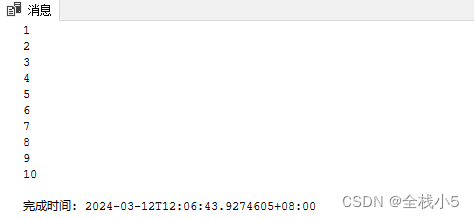
-- 定义变量 declare @id int -- 定义游标并赋值 declare cursor_name cursor for select id from student_table -- 打开游标 open cursor_name -- 逐行获取数据 fetch next from cursor_name into @id while @@fetch_status=0 begin print(@id) -- 下一条记录 fetch next from cursor_name into @id end结合临时表
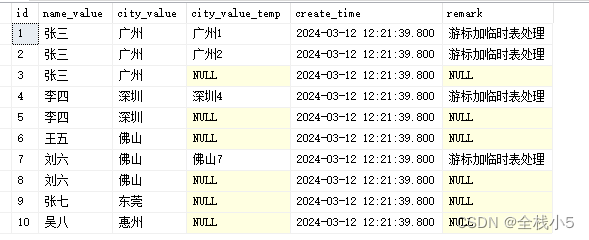
1)定义变量
2)定义游标并赋值
3)打开游标
4)逐行获取数据
5)创建局部临时表
6)第二层遍历
7)将当前第二层遍历记录移除
8)更新表字段
9)下一条记录
10)关闭游标
11)释放游标
-- 定义变量 declare @name_value nvarchar(50) declare @city_value nvarchar(50) declare @repeatcount int declare @maxid int -- 定义游标并赋值 declare cursor_name cursor for select name_value,city_value,count(1) repeatcount,max(id) maxid from student_table group by name_value,city_value having count(1)>1 -- 打开游标 open cursor_name -- 逐行获取数据 fetch next from cursor_name into @name_value,@city_value,@repeatcount,@maxid while @@fetch_status=0 begin --print(@name_value) -- 创建局部临时表并赋值 drop table #temp_table create table #temp_table ( id int, name_value nvarchar(50), city_value nvarchar(50), create_time datetime ) insert into #temp_table(id,name_value,city_value,create_time) select id,name_value,city_value,create_time from student_table where name_value=@name_value and city_value=@city_value -- 第二层遍历 declare @id int while exists(select id from #temp_table) begin select top 1 @id=id from #temp_table print(@name_value+convert(varchar,@id)) -- 将当前第二层遍历记录移除 delete from #temp_table where id=@id -- 更新表字段 if @id!=@maxid begin update student_table set city_value_temp=(@city_value+convert(varchar,@id)),remark='游标加临时表处理' where id=@id end end -- 下一条记录 fetch next from cursor_name into @name_value,@city_value,@repeatcount,@maxid end -- 关闭游标 close cursor_name -- 释放游标 deallocate cursor_name select * from student_table知识点
在 SQL Server 中,游标和临时表都是用于处理数据的工具,但它们的使用方式和目的略有不同。
游标(Cursor):
游标是一种用于逐行处理数据的数据库对象。通常在需要逐行访问数据并执行复杂操作时使用。游标可以使用以下步骤创建和操作:
- 声明游标:定义一个游标并指定查询的结果集。
- 打开游标:执行查询并将结果集放入游标中。
- 逐行获取数据:使用 FETCH 语句一次从游标中获取一行数据。
- 处理数据:对获取的数据进行操作。
- 关闭游标:处理完数据后关闭游标,释放资源。
示例:
DECLARE @id INT DECLARE cursor_name CURSOR FOR SELECT id FROM table_name OPEN cursor_name FETCH NEXT FROM cursor_name INTO @id WHILE @@FETCH_STATUS = 0 BEGIN -- Process data FETCH NEXT FROM cursor_name INTO @id END CLOSE cursor_name DEALLOCATE cursor_name临时表(Temporary Table):
临时表是一种临时存储数据的表,它们一般用于在当前会话中临时存储和处理数据。SQL Server 提供了两种类型的临时表:全局临时表和局部临时表。
- 局部临时表:以 # 开头,在当前会话中可见,在会话结束时自动删除。
- 全局临时表:以 ## 开头,对所有会话可见,当创建它的会话结束时自动删除。
示例:
-- 创建局部临时表 CREATE TABLE #temp_table ( id INT, name VARCHAR(50) ) -- 插入数据 INSERT INTO #temp_table VALUES (1, 'Alice'), (2, 'Bob') -- 查询数据 SELECT * FROM #temp_table -- 删除临时表(在会话结束时会自动删除) DROP TABLE #temp_table游标用于逐行处理数据,适用于复杂逐行操作;而临时表用于临时存储和处理数据,适用于需要临时保存中间结果的情况。
在实际应用中,要根据具体需求选择合适的工具来处理数据。
文章推荐
【Sql Server】通过Sql语句批量处理数据,使用变量且遍历数据进行逻辑处理
【新星计划回顾】第六篇学习计划-通过自定义函数和存储过程模拟MD5数据
【新星计划回顾】第四篇学习计划-自定义函数、存储过程、随机值知识点
【Sql Server】Update中的From语句,以及常见更新操作方式
【Sql server】假设有三个字段a,b,c 以a和b分组,如何查询a和b唯一,但是c不同的记录
【Sql Server】新手一分钟看懂在已有表基础上修改字段默认值和数据类型
总结:温故而知新,不同阶段重温知识点,会有不一样的认识和理解,博主将巩固一遍知识点,并以实践方式和大家分享,若能有所帮助和收获,这将是博主最大的创作动力和荣幸。也期待认识更多优秀新老博主。














